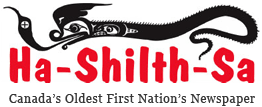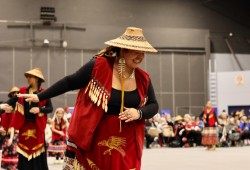Like a fog horn guiding ships through ocean waves, the deep sound of a conch shell called dancers to the floor as the slow, steady beat of a drum group reverberated off Vancouver’s PNE Forum walls.
Over 10,000 loud and proud First Nations came together to take part in Hoobiyee 2025 Nisga’a Ts’amiks Edition and the Nis’gaa New Year on Feb. 28 and March 1, showing unity and strength in the journey to revitalize Indigenous culture; a culture the Canadian government nearly stamped out with potlatch bans, residential schools and the ‘60s scoop.
“If you feel emotional, it’s because the drums are calling you. It’s in your DNA. If you feel like dancing, get up and dance,” said Andrea Burrell, president of the Nisga'a Ts'amiks Vancouver Society and Nisga’a dancer since 2006.
“Dance like no one is watching because truly that’s how it feels on the floor. You’re only doing it for yourself. Everything that we do, it’s from inside. You don’t think about the other people when you are dancing. You think about yourself,” she said.
The story of Hoobiyee all starts back in the homeland of the Nisga’a people along the Nass River valley in northwest B.C.
Tony Robinson, Nisga'a Ts'amiks Vancouver Society CEO, says the celebration is rooted to the harvest of oolichan or ‘candlefish’, a small silver fish that would return to the coastal rivers after winter.
“It’s about a two week process where Nisga’a people would sun dry oolichan, smoke the oolichan and make our famous grease out of the oolichan,” explained Robinson, a second generation Nisga’a whose late father went to St. Michael’s Residential School in Alert Bay.
He was uncertain as to how long Hoobiyee has been celebrated in Nisga’a traditional territory, but says the Vancouver Ts’amiks edition is entering about 20 years. There are about 8,000 Nisga’a citizens with roughly 2,000 residing within Greater Vancouver, Victoria and Vancouver Island regions.
‘Reclaiming Our Spirit’ was the theme for the two-day cultural festival, which also showcased Indigenous artists, services, vendors and traditional food like bannock.
“With reconciliation, what’s happening right now, we’re decolonizing. First Nations our getting recognized for everything we’ve been through,” said Robinson.
“It’s amazing when you get 17 dance groups here and see how they are reclaiming their spirit and culture through song and dance. It’s all different aspects of the culture. It’s amazing to see what they can do,” he continued.
Tla-o-qui-aht First Nation sent one of the largest dance groups and singers on the Hoobiyee program this year.
“Many of us needed a culture event like this for a long time. Keep it going,” TFN Chief Elmer Frank told the crowd after their performance.
Other Nuu-chah-nulth Nations to perform were Ahousaht First Nation and Mowachaht/Muchalaht First Nations.
“We’ve been able to watch dance groups grow,” said Burrell. “It’s been awesome seeing all the babies on the floor. We have one family with four generations that are dancing in our group.”
Gitxaala First Nation Riley Caputo, 34, experienced his first Hoobiyee with his eight-year-old son Tinucw.
“It’s amazing to raise your kids into this. I didn’t get that when I was younger. I could have had a chance to learn it in the past, but it just didn’t work out for me,” said Caputo after drumming with his son in the Grand Entry, a Hoobiyee highlight for many.
“I’m gonna try do this as much as I can from now on,” he said.
Honouring the late Chief Sim’oogit Hay’mass Chester Moore
Time was taken on Feb. 28 to share stories and honour the departed Nisga’a hereditary chief Chester Moore and his family.
Chief Moore was a respected leader, prolific totem carver and large part of the Nisga’a cultural community. He also composed several songs for the Hoobiyee dance group.
“I am so very proud and grateful for what you have done for our families,” said Chief Clifford Morgan to the crowd. As the oldest nephew of Moore, Chief Morgan will carry on the name of the Sim’oogit Hay’mass House.
“I hold the name of our house, but it doesn’t belong to me personally,” said Chief Morgan. “Our late uncle has also created many other celebrations. We have Salmon Fest in May. I’d like to thank you for all the work you have done. It is deeply moving and gratifying,” said Chief Morgan.
A special award was also presented by the Coastal Nations Coast Guard Auxiliary to Nisga’a emergency response manager Anthony Moore for getting the search-and-rescue service going within their territory.
“It’s been a huge project on my part in getting it going for the Nisga’a Nation, and to have it where it’s activated today is just a huge buzz to our people to ensure that we’re safe on the water. Thank you all for your time, and HOOBIYEE,” Moore called out to the crowd.















